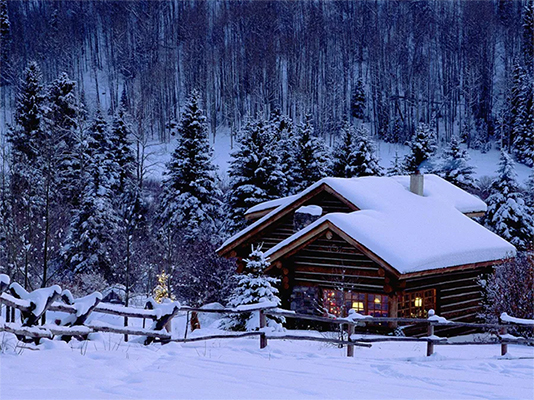
EVERGREENS THAT SATISFY A YEARNING FOR THE NORTH
By Kathy Torres
It’s no secret that many people from the northern states move south to escape cold weather, ice and snow, high cost of living, to access beach life, or even to get a little closer to SEC Football. (Possible? Probably!) Regardless of the incentive to live in the south, the difference in climate holds both positive and negative realizations when it comes to gardening and landscape characteristics. A much longer growing season is a definite plus, however, with that comes the heat and humidity that can often be challenging to maintaining happy, healthy plants. Milder temperatures in winter with fewer hard freezes creates a great environment for fruit trees, but not so much for the magnificent Cedar, Spruce and Fir trees that line the highways from Maine to Washington State. How wonderful it must be to drive to a nearby tree farm to cut your own Christmas tree! We have no idea of that experience here in the south, but thank goodness we can shop Wingard’s Market (Frasier Firs will be available the Monday before Thanksgiving) and enjoy the wintery fir tree for a little while. So many of the beautiful evergreen trees and shrubs that can be grown up north will just not grow here because our summers are too hot and winters are not cold enough. Customers who have relocated from northern states often visit Wingard’s looking for similar plants that can be substituted for the beloved evergreens they left behind.
Many pyramid-shaped evergreen trees are prominent in northern landscapes. While there are not as many options for us in the south, several come to mind that have the same look. Arborvitae AKA Thuja, variety Green Giant is an excellent evergreen specimen tree (focal point) or screen plant growing to a mature height of 40-60 feet tall and 12-18 feet wide. You may remember the Leyland Cypress tree that was widely planted in recent years. The Leyland Cypress developed disease issues and is no longer recommended. The Arborvitae Green Giant looks very much like the Leyland Cypress and offers a perfect fast growing substitution option. Arizona Cypress ‘Carolina Sapphire’ (developed by Clemson University and South Carolina Forestry Commission) is another attractive pyramid-shaped evergreen with a lighter, silvery blue-green color, about the same mature size, also very fast growing. Both thrive in full or part sun (at least 6 hours), are drought tolerant once established, and can stand the heat and humidity. Cuttings are long-lasting and perfect for natural Christmas wreaths and garlands. An added plus for Carolina Sapphire is the appearance of small cones in winter on the graceful, airy branches. For a smaller pyramid-shaped evergreen, Blue Point Juniper is a contender with a mature height of 12 feet and width of 6-8 feet. Blue Point is densely branched with blue-green foliage, grows at a moderate rate, and also thrives in full to part sun.
All three of these tree varieties require little or no pruning to maintain their shape and density. Just be sure to plant the big ones in a spot that will handle their mature size. If you’re planting several in a line for screening, don’t plant them too close together or you may be inviting disease problems due to lack of air flow once they are mature. For both the Green Giant and the Carolina Sapphire, a distance of 6-8 feet apart is best; plant Blue Point Juniper trees 4-5 feet apart.
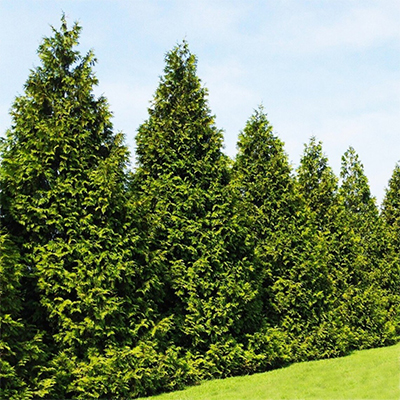 Arborvitae Green Giant |
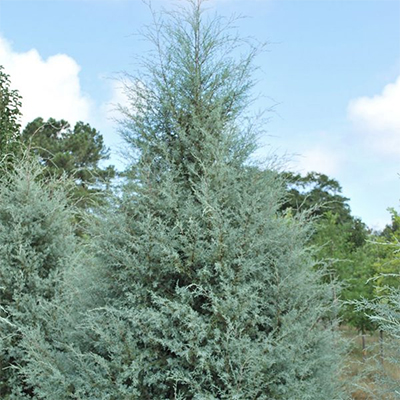 Arizona Cypress Carolina Sapphire |
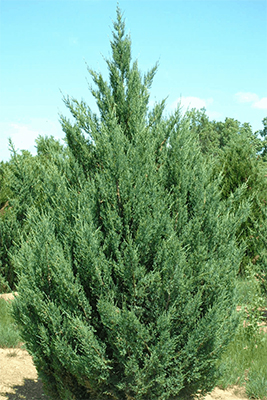 Blue Point Juniper |
A slower growing evergreen, the Eastern Red Cedar is native to South Carolina and can be found all the way from eastern coastal Canada south to the Gulf Coast of the United States (Agricultural zones 2 to 9). Native plants give you an extra advantage because they have adapted to the environment, making them much more likely to thrive when you add them to your landscape. In many cases, established native plants can grow with little to no fertilizer, pesticides, and even irrigation. In this way, native plants generally help protect water resources. The Eastern Red Cedar is really not a Cedar, it’s actually a Juniper (like botanical names aren’t confusing enough). Its dense, blue-green scale-like needles turn bronze in fall. With a mature height anywhere from 30-40 feet tall and 10-20 feet wide, the Eastern Red Cedar offers an excellent habitat for birds; female trees produce blue, berry-like fruit.
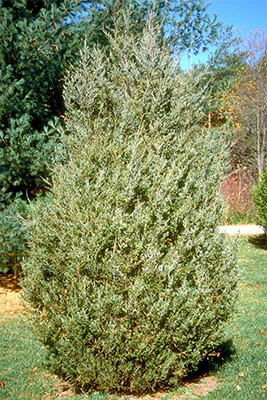 Eastern Red Cedar |
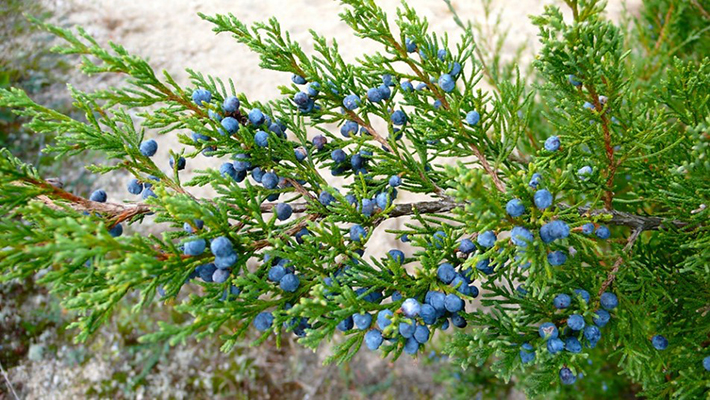 Berries of Eastern Red Cedar |
A more ornamental conifer (another word for evergreen trees that produce cones), is Japanese Cryptomeria, AKA Japanese Cedar. This tree, known as sugi in Japan, is the national tree. It is perfect to stand alone for interest in a sunny spot in the landscape, with small cones appearing in fall. As it grows, branches separate, making it’s appearance slightly less dense and pyramidal than some of the trees mentioned above. Very slow growing, it may not be the best choice for a hedge or screen. It may reach 50-70 feet tall and 20-30 feet wide, but probably not in your lifetime. Don’t let this discourage you, because the beauty and interest of Japanese Crytomeria, even when it’s small, makes a special, out of the ordinary, addition to any garden bed. Also, if you’re in to Bonsai, it’s a perfect candidate.
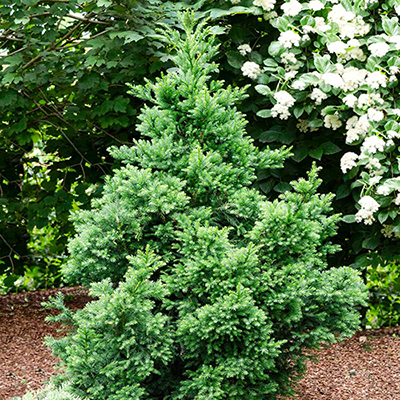 Cryptomeria |
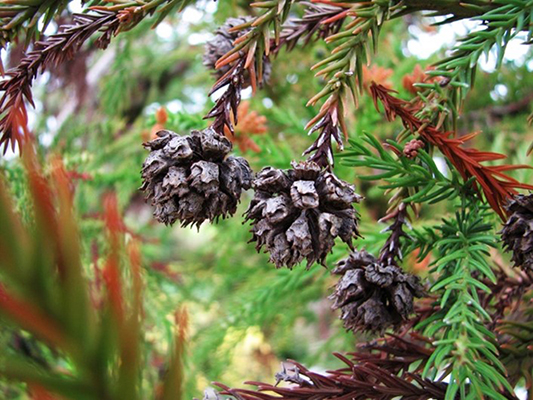 Cones of Cryptomeria |
Now that you have a few ideas for trees to give you that “northern” feel, consider other evergreens that provide year round foliage and compliment them. Most southern landscapes contain a combination of deciduous (drops leaves) and evergreen plantings. Because our winter is fairly short, we can handle the bare branches for a bit, however, they are certainly less noticeable when mixed with evergreens. Here are a few “southern” evergreens that we highly recommend.
Japanese Plum Yew, Cephalotaxus harringtonia, is a wonderful alternative to boxwood for a low growing, evergreen border/hedge. Native to Japan, northeastern China, and Korea, it is often cultivated for its edible fruit (must have both male and female plants). Japanese Plum Yew is different from Japanese Yew, Taxus cuspidata, which bares poisonous seeds and leaves. Look for the botanical name when you are looking for it to distinguish the varieties. Many Yew varieties do not tolerate heat like we have in the south, however Japanese Plum Yew is suitable for USDA Zones 6 to 9 (we are 8). The ‘Yewtopia’ cultivar has a growth habit which is rounded and spreading, usually wider than tall. Mature size is 2-3 feet tall by 4+ feet wide. In our warm climate, this Yew prefers part sun (morning sun, afternoon shade) or full shade and well-drained soil. The lush, dark green foliage is needle-shaped with a lighter green underside. Perfect for mass plantings, Japanese Plum Yew maintains its color year round. It is not likely to need pruning, and will typically not have disease and pest problems. Another cultivar, Cephalotaxus harringtonia ‘fastigiata’ is upright, reaches 8-10 feet in height, making it a great specimen plant in a garden bed.
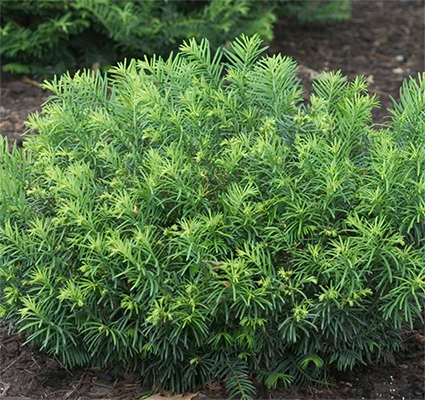 Cephalotaxus harringtonia |
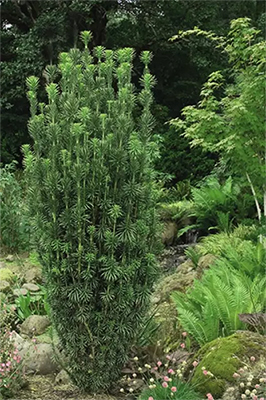 Cephalotaxus harringtonia ‘fastigata’ |
Podocarpus is another Yew-like shrub/tree, though not actually in the Yew family. The foliage looks exactly the same, and it shares the same growing requirements, but the common variety can grow quite tall (10-15 feet). Podocarpus is easily pruned to whatever shape you desire. You’re likely to see this plant espaliered (pruned to grow on a trellis) or planted in rows to create a garden wall, adding a formal touch. Because it is slow growing, pruning is really only needed for shaping. On your next visit to Charleston, peek through the gate of one of the historical homes on Meeting Street and you’re likely to see it.
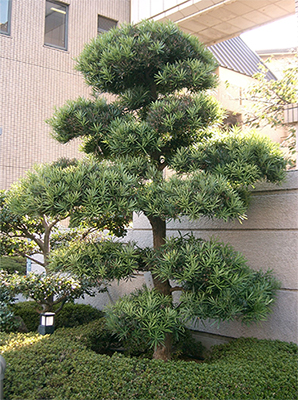 Podocarpus Topiary |
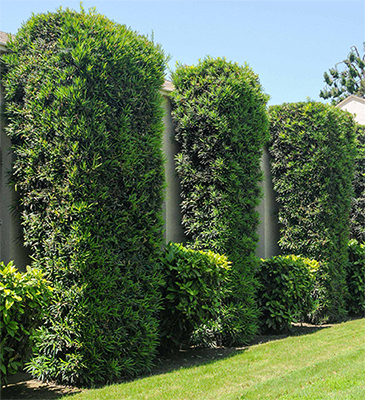 Podocarpus |
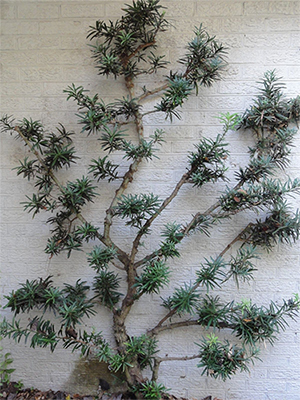 Podocarpus Espalier |
There are many other evergreen trees and shrubs that will provide year round greenery, some with the added benefit of blooms or berries. Holly trees and shrubs make wonderful anchor plants on the corner of a home or as a focal point in a garden bed. Rich, green foliage serves as the backdrop for the prickly foliage and red berries appearing in winter. The “Big Mama” of the Holly family is Nellie Stevens, growing as tall as 30 feet and just slightly less in width. Needle Point is another variety, not quite as enormous as Nellie Stevens, with a mature height and width of 15-20 feet. Both of these varieties have a natural, Christmas tree shape. For a more compact, round shrub, try Dwarf Burfordi Holly, great for foundation planting or a hedge. It will grow 4-5 feet tall and wide.
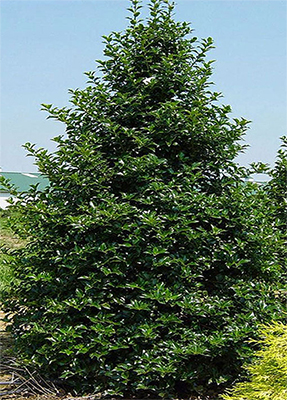 Nellie Stevens |
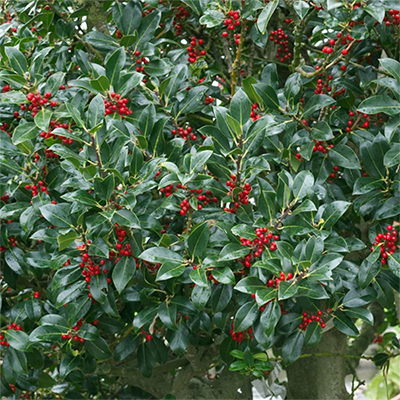 Needle Point |
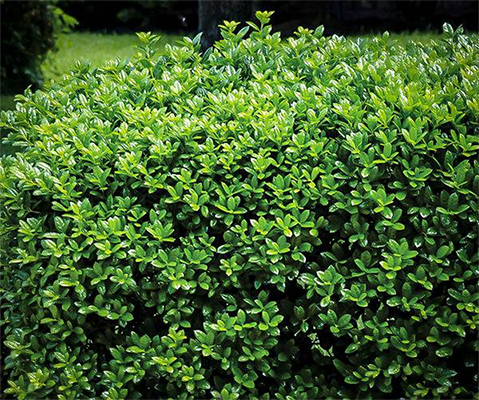 Dwarf Burfordi |
Did I mention blooms? Two favorite evergreens for the landscape with gorgeous blooms are Magnolia and Camellia. Not likely to survive in northern climates, these beauties represent yet another reason to move down south! The Southern Magnolia is a large, broadleaf evergreen tree that is known for attractive glossy dark green leaves and large, extremely fragrant flowers appearing in summer. Pyramidal in growth habit, Southern Magnolia typically grows 60-80 feet tall with a spread of 20-40 feet wide, and a trunk diameter of 3 feet. Full or part sun is best (at least 6 hours). Magnolias are one of the oldest known tree species in the world. Common varieties include Brackens Brown Beauty, Kay Parris and Claudia Wannamaker. If your landscape isn’t large enough to accommodate the big guys, there are other smaller varieties, such as Little Gem and Teddy Bear that won’t require as much space and will give you the same beautiful foliage and blooms.
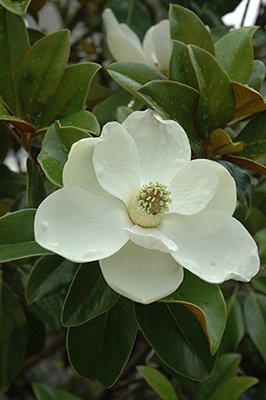 Magnolia Bloom |
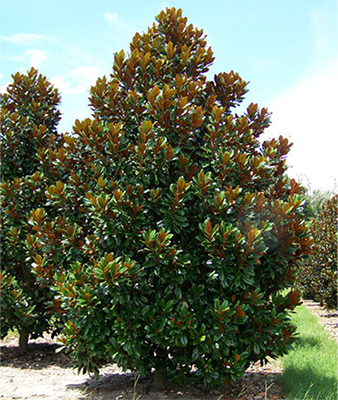 Southern Magnolia |
Finally, the Classic Camellia is a must for the southern landscape. As summer’s end approaches, many of the stunning flowers you planted are looking a bit scorched, the rose bushes have lost the fresh appearance you enjoyed in the early spring, and soon the branches on the deciduous shrubs and trees will be bare. Camellia sasanqua is about to shine as buds appear amid the waxy, deep green foliage. Blooms will begin to appear in October or November. Camellia japonica will bloom in the winter months (December to March). Camellias are available in many sizes with a variety of bloom colors, and both types (sasanqua and japonica) are evergreen. Camellia japonica is shade loving, however, some sun is needed to encourage blooming. It’s best to avoid planting in full sun; morning sun/afternoon shade or filtered sun is best. Camellia sasanqua can take more sun, but full sun is still too much, so use the same philosophy for both. Avoid planting in dense shade because it will likely prohibit blooming. Fall is the best time to plant, and I have it on good authority that Wingard’s camellia inventory is fully stocked!
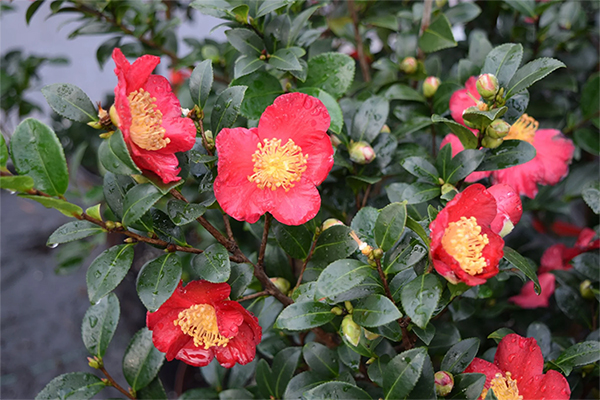 Camellia sasanqua ‘Yuletide’ |
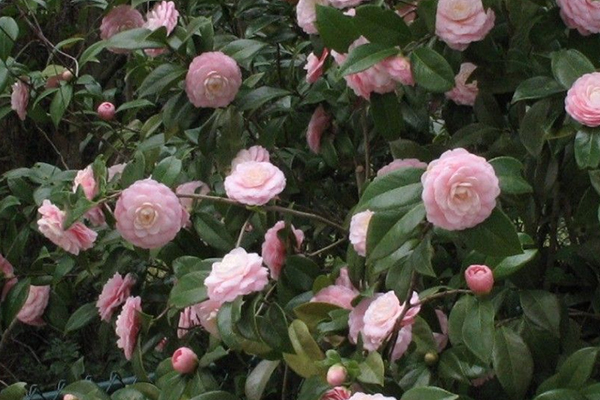 Camellia japonica ‘Pink Perfection’ |
NOTE: For more on Camellias, click HERE for Wingard’s Blog entitled “The Classic Camellia.”
As we approach the Thanksgiving and Christmas holidays, most “northerners” who live here in the south are probably grateful that a snow shovel is not a part of life anymore, but, there may be a yearning for the familiar landscape they used to know. We can’t capture it exactly, but there are many beautiful substitutes that may just fill the void. So, consider trying a few trees and shrubs that remind you of that place you lived before… and embrace a few southern treasures now that you’re here. The staff at Wingard’s Market are always available to help you make the transition!

